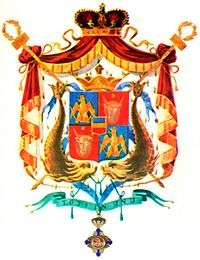Marș triumfal
Marș triumfal (Romanian: Triumphant March), or Marș triumfal și primirea steagului și a Măriei Sale Prințul Domnitor (Triumphant March and Reception of the Flag and His Excellency Prince Ruler) by its long name, was the first anthem of Romania. It is a piece without lyrics composed by Eduard Hübsch. In 1861, a contest was organized to decide the national anthem of the country with a prize of 100 golden coins. Hübsch was the winner, and the march was officially adopted on 22 January 1862.[1][2]
| English: Triumphant March | |
|---|---|
 The unofficial coat of arms of the Romanian United Principalities (1864–1866) | |
National anthem of Romania | |
| Music | Eduard Hübsch, 1861 |
| Adopted | 1862 |
| Relinquished | 1884 |
| National anthems of Romania | ||||||||||||||
|---|---|---|---|---|---|---|---|---|---|---|---|---|---|---|
|
||||||||||||||
It is essentially the same song as Trăiască Regele, with lyrics written by Vasile Alecsandri and which was the anthem of Romania between 1884 and 1948. Marș triumfal is now used by the Romanian Army for ceremonies or high-ranking foreign persons,[1][2] being known as Marș de întâmpinare al Armatei României (Welcoming March of the Romanian Army).[3]
References
- Chelaru, Carmen (2018). "Romanian national anthems, historical, stylistic and aesthetic considerations". Artes. Journal of Musicology. 18 (1): 207–229. doi:10.2478/ajm-2018-0013. ISSN 2558-8532.
- Diaconu, Camelia (25 November 2019). "Imnul României "Deșteaptă-te, române" – Versuri și istoric". Libertatea (in Romanian).
- "Cele șapte imnuri naționale ale românilor". Radio România Cultural (in Romanian). 11 May 2018.